Klaus J. Enzmann
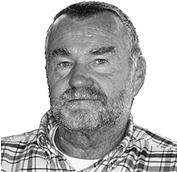 |
Klaus J. Enzmann is a qualified engineer, catamaran designer and author of books about catamarans. Klaus is an experienced and successful regatta sailor. Download Picture (300dpi) |
_____________________________________________________________________________________________________
50
years of catamarans
Klaus J. Enzmann was born in 1940
in Munich and started sailing a dinghy on a nearby lake when he was 14 years
old, moving on to sailing Flying Dutchman regattas at age 19. When DN ice
yachts were developed 1960s, he tried them out and realised that it was possible
to exceed speeds of 100 km/h just thanks to the power of the wind.
During a subsequent visit to England he saw a catamaran sailing on the river
Thames, one of the first Shearwater models developed by the Prout brothers.
Klaus was immediately convinced and won over by the speed, the concept and
the reasoning behind this new type of sailboat.
Back in Germany, Klaus was undaunted by criticism and doubts coming from conservative
sailing circles and went ahead to build his first fibre glass C-Class catamaran
in his garage. Many new designs were to follow and Klaus' vision of a lightweight
sport catamaran became reality. As he was not just a sailor but also a passionate
glider pilot, Klaus also built and repaired gliders, learning a lot about
lightweight construction as he went along.
 |
In 1968, Klaus won international acclaim thanks to his second A-Class
catamaran design called the "Wing-A" Cat. In a village called Erling
on a lake near Munich, he started his own boatyard and since 1968
has built more than 450 "Wing-A" Cats and 112 "Tornados" (under licence
from IYRU). It was in this boatyard in 1977 that the first Tornado
hull employing the honeycomb lightweight construction technique was
built. Starting in 1974, the Italian boatyard "Catamaran Sport Italy"
started building the "Wing-A" Cat under licence. Even though a typical
A-Class catamaran is well defined according to the IYRU rules, the
"Wing-A" Cat managed to dominate the A-Class as if it had its own
class. |
|
 |
As an example, in the 1979 World Championship at Lake Garda in Italy, 89 of the 92 A-Class catamarans were "Wing-A" Cats. Klaus was co-founder of the German A-Class Catamarans Association (VDAC) and also of its international counterpart, IACA. After winning the A-Class European Championship in Sheppey (England) and winning "Yacht" magazine's nomination for "Sailor of the year 1968", Klaus was referred to as the "Bavarian Catamaran King" during a congratulatory speech at his yacht club and has never managed to get rid of the title since! |
|
 |
In 1975, during his period of success with the "Wing-A"
Cat, Klaus designed a keel less catamaran called TOPCAT, similar to
the "Wing-A" Cat, but possessing a foldable mast (airtight at the joint)
which enabled easy transportation on car roofs, easy set-up and made
it easy to right the boat after capsizing. The TOPCAT also possessed
the kick-up rudder made of aluminium which has become a trademark in
its own right. In 1978, "Catamaran Sport Italy" built the first TOPCAT
under licence and has continued doing so to this day. Following that,
Klaus hired his sailing friend Bernd Breymann, a professional salesperson.
|
|
 |
The TOPCAT was then exhibited for the first time at the "Boot" trade fair in Dusseldorf. It was the beginning of a German catamaran success story. The TOPCAT was later followed by the "TOPCAT F2", then in 1983 by the "TOPCAT 18 Spitfire", then by the "TOPCAT K1" (18-foot ISAF class), then by the "TOPCAT K2" and finally by the "TOPCAT K3" (the first regatta-class catamaran for single-handed sailing with a spinnaker). Over time, with sales of over 10,000 units, TOPCAT became Europe's most successful catamaran manufacturer.
|
|
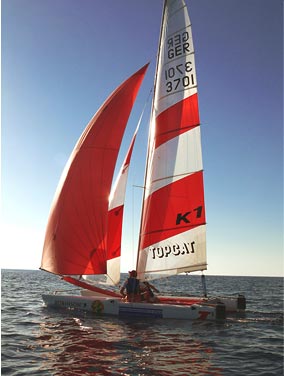 |
In 1979, working with the "Yacht" magazine journalist Wolfgang Barth, Klaus wrote a book called "This Is Catamaran Sailing". The book has been translated into several languages, republished several times and has become the standard reference book for sporting catamaran sailing. In 1981, Klaus wrote the curriculum for the training of catamaran sailing instructors, which is used to this day. The German Assocation of Sailing Schools (VDS) was the first association to adopt this training method. He wrote a training manual for this purpose which has become the basis for teaching catamaran sailing in almost all sailing schools. | |
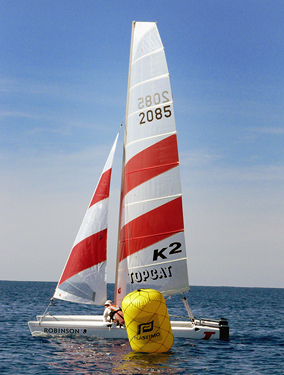 |
In 1986, based on the idea of
a trailerable cruising catamaran which Klaus and Bernd originally wanted
to take with them on holidays, the extremely lightweight racing boat "TC35"
for offshore regattas was built at the specialised boatyard "Denninger
and Maile". As the new TC35 just about fit into the 40-foot class, Klaus
was able to sign up the French company "Primagas" as a sponsor. In its launch year, the TC35 was sailed successfully in several regattas in France. However, at the end of the regatta season, both owners realised that too much time and material was required to keep the TC35 going, so they sold it to a Swiss businessman who was very keen on catamarans. |
|
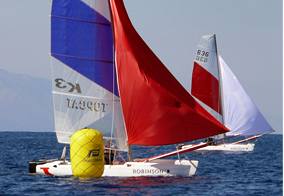 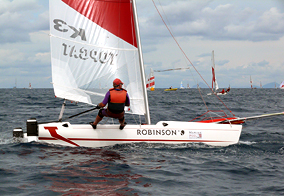
|
As early as 1986, Klaus started
building a catamaran with mechanically- adjustable hydrofoils (Hook control
method). After building 2 further prototypes in the following years, he
achieved a breakthrough in 2010 by building a catamaran with electronically-controlled
hydrofoils. The Enzmann-Foiler will be exhibited at the "Boot" 2012 trade fair in Dusseldorf, showing a whole range of patented innovations. The boat will sail as a catamaran on 3 digitally-controlled hydrofoils and is predicted to become the fastest sailboat which is mass-produced. Text and translation by Amy Bus. Summary of an interview for the magazine "Yachting", updated in 2011. All pictures are from Catlift GmbH |
Timeline
1959- First regatta victories in a Flying Dutchman
1961- Built a DN ice yacht
1962- Designed and built a C-Class catamaran "Samaka 1"
1964- Designed and built the "Wing 1", an A-Class cat with sail mast
1968- Launch of the first "Wing-A" catamaran at Hamburg trade fair
1972- Started building the "Tornado" under licence from IYRU
1974- Catamaran-Sport-Italy starts building the "Wing-A" Cat under licence
1975- Built a keel less prototype catamaran, the predecessor of the TOPCAT
1977- Built the first "Tornado" using honeycomb lightweight construction
1978- Built the first TOPCAT and launched it at Düsseldorf trade show
1979- Built the first TOPCAT F2 - Publisher "Delius Klasing" publishes the
book "This Is Catamaran Sailing"
1981- Klaus creates the first curriculum for the catamaran sailing course
- VDS adopts
Klaus' work for the sailing course and sailing instructor course
1983- Built the first TOPCAT 18 Spitfire
1985- The Spitfire gets a spinnaker
1986- Built the 35 ft. cruising catamaran TC 35 "Primagas" - First tests using
hydrofoils on a catamaran
1987- Built the first TOPCAT K1
1992- Built the first TOPCAT K2
1994- Built a catamaran with mit hydrofoils and mechanical control
1999- Built the first TOPCAT K3
2000- Started a new company "Catlift" to provide engineering services for
catamarans
2010- Built the first Enzmann hydrofoil catamarans with digital hydrofoil
control
© Catlift GmbH & Co. Entwicklungs KG 2012 - Alle Rechte vorbehalten. Impressum.


